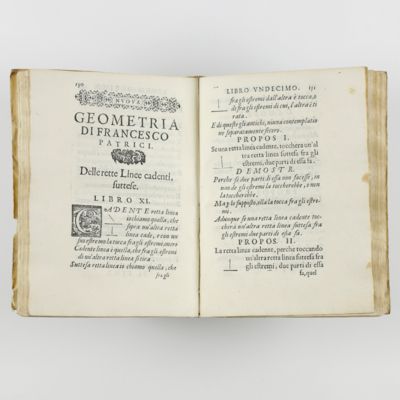"The turning point and dividing line between ancient and modern geometry" first edition in fine condition
Patrizi, F.
Della nuova geometria di Franc. Patrici. Libri XV.
Published
1587
Item ID
72610
€9,500.00
Ferrara, Vittorio Baldini, 1587. Small 4to (20.0 x 15.0 cm). Title page with engraved vignette; [vi], 218, [i] pp.; numerous text illustrations. Contemporary limp vellum with handwritten title in an old hand on the spine.
A very well-preserved copy of the rare, true first edition of this work on geometry and space by the Italian neoplatonist philosopher and mathematician of Croatian descent, Franciscus Patricius, or Francesco Patrizi (1529-1597). "In December 1586 [he] published, in Ferrara, a singular treatise Della nuova geometria (On a New Geometry), in which he claimed to have finally found that via regiato the discipline here in question which had escaped Euclid and all the mathematicians before him. It was, of course, a very imperfect work, in which Patrizi’s mathematical incompetence quickly comes to the fore; nor does it contain a single relevant geometrical result. The material it deals with - at great length over 15 books, 238 theorems and more than 200 pages - does not in fact extend beyond the simplest results of Euclid’s Elements. In fact, it scarcely covers the first half of Book One of this work. On the other hand, it contains quite a few mistakes. This unfortunate book, nonetheless, remains one of the most significant and important documents for the history of mathematical epistemology in the Renaissance, and might indeed almost be considered the turning point and dividing line between ancient and modern geometry. Its contents, very innovative for its age, consist in an almost uninterrupted chain of logical arguments in forma which proceed from simple definitions and aim (mostly by simple modus tollens) to prove the principal theorems of elementary geometry." (De Risi). Patrizi was appointed to the Chair of Philosophy at the University of Ferrara by Duke Alfonso II; this work, however, was dedicated to Carlo Emanuele di Savoia (1562-1630), Duke of Savoy from 1580 to 1630. Later, this work was translated into Latin. "Franciscus Patricius was born in Cres (Italian: Cherso), today in Croatia, then the territory of the Republic of Venice. According to the family legend, the Petriš family (Patricius was his Latin name) was of noble (patrician) origin from Kingdom of Bosnia and was forced to flee from the crumbling Bosnian kingdom after the Ottoman invasion. As a young man, he traveled the Mediterranean with his uncle Georgius (Juraj) Patricius, who commanded a galley in the wars against the Ottoman Empire. He gained the patronage of the Greek Orthodox Bishop of Cyprus, who brought him to Venice, where his abilities were immediately recognized. He studied economy in Venice, then he moved to study in Ingolstadt under the patronage of his cousin Matthias Flacius (Matija Vlačić). Then he went to study medicine and philosophy at the University of Padova. Here he was elected twice as a representative of the students from Dalmatia. After graduation he lived in different cities in Italy: Ancona, Rome, Bologna, Ferrara, Venice. He later moved to Cyprus where he spent seven years. Here he attended upon the Bishop of Cyprus who send him back to Italy, where he traveled to Venice, Padova, Genoa, and even to Barcelona. He finally went to live in Ferrara, a center of Platonism in Italy, where he was appointed to the chair of philosophy at the University of Ferrara by Duke Alfonso II.
read more
He was subsequently invited in Rome by Pope Clement VIII in 1592, where he spent five years as the chair of Platonic philosophy. Here he became a member of the Council of St. Jerome, at the Illyrian College of St. Jerome. Patricius died in Rome, and he was buried in the church of Sant'Onofrio, in the tomb of his colleague Torquato Tasso. In spite of his continual controversies with the Aristotelians, Patricius managed to make a comprehensive study of contemporary science, publishing in 15 books a treatise on the New Geometry [this work], as well as works on history, rhetoric and the art of war. He studied ancient theories of music, and is said to have invented the thirteen-syllable verse form known subsequently as versi martelliani. In his philosophy he was mainly concerned to defend Plato against the followers of Aristotle." (Wikipedia). Includes the errata leaf. With wide margins. Old ink erasures on title page. four neat, additional ink drawings in an old hand, added in the margin of pages 111-112. Small cut to spine and one corner slightly frayed, ties wanting. An untouched copy in its contemporary vellum binding. In very good condition. Vincenzo De Risi (2015) Francesco Patrizi and the New Geometry of Space.
read less




